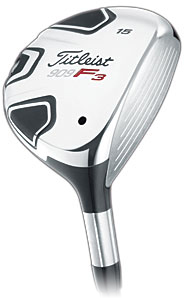 Without even looking at my Titleist 906F4 review, I almost began this review the same way: “Fairway woods rarely get the credit they deserve…” Of course, that’s as true then as it is today, and as my game evolves and improves, I find myself relying on my 3-wood more and more, particularly from the tees of holes on which I used to hit driver.
Without even looking at my Titleist 906F4 review, I almost began this review the same way: “Fairway woods rarely get the credit they deserve…” Of course, that’s as true then as it is today, and as my game evolves and improves, I find myself relying on my 3-wood more and more, particularly from the tees of holes on which I used to hit driver.
I carry only one fairway wood. It’s a 15° 3-wood sandwiched between a driver and a 17° hybrid that serves as my 5W/2I replacement. Except my putter, you could probably remove any club in my bag without affecting my final score by much, but remove my 3W and I might lose between half a shot and a full shot every time I would have needed it.
The 3W may not have the versatility of a hybrid, the sex appeal of a driver, or the scoring impact of any of my wedges, but when I need my 3W – when I pull it from the bag – it’s often for a situation that only a 3W can handle: from the tee on a tight par four, finding the putting surface on that incredibly long par three, or setting me up for an eagle on a par five.
I’m picky about my 3W, and you probably should be too.
Technology and Design
Titleist has been doing the “two-product lineup” thing for awhile now: two driver models (907D1/D2, 983K/E, etc.), two balls (Pro V1/V1x, DT Carry/Roll), two iron models (ZM/ZB, 695MB/CB, etc.), and, in fairway woods, the 906F2/F4. Released a year apart, the 906 line paired one shallow-faced club that offered help getting the ball up with a deeper-faced “sister” model meant to help keep the ball down.
The release of 909F2 and 909F3 gets Titleist back to releasing both clubs simultaneously. They’ve stuck with the “shallow/up” and “deep/down” combination. The numbers have flipped – 906F4, the “shallow/up” one becomes 909F2, while the “deep/down” 906F2 becomes 909F3. This, Titleist will tell you, pairs them nicely with the performance characteristics of 909D2 and D3.
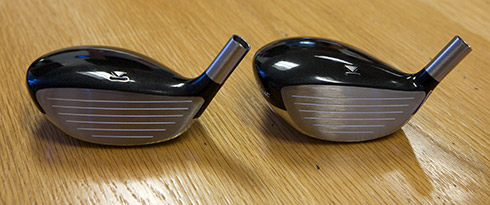 The 909F2 (left) and 909F3 (right). Note the difference in face width and depth.
The 909F2 (left) and 909F3 (right). Note the difference in face width and depth.
The 909F2 (successor to 906F4) features a shallow, extended face, a round profile, and a mid to high launch with mid spin. F2 has a half degree higher loft (13.5°, 15.5°, 18.5°) and a lower CG for a higher launch without increased spin compared to F3. The deeper CG adds to the stability, increases MOI, and increases distance on mishits. The larger, longer face profile provides more confidence and forgiveness, particularly for a player who wants to use the club primarily from the fairway.
The 909F3 (successor to 906F2) features a deep face and a full pear profile with mid launch and low spin. The half degree lower loft (vs 909F2 – available models are 13°, 15°, and 18°) and deeper face promote a boring trajectory from both tee and turf, while the deeper CG adds to stability, MOI, and distance on mishits. The 909F3’s deeper face and smaller, pear profile clubhead will provide more confidence to players that prefer a compact looking fairway metal and the performance aligns with those who like to hit their fairway metal from the tee.
Both fairway metals continue with several technologies found in 906: the multi-relief sole puts the contact point close to the face to minimize turf resistance and to reduce bounce. The hosel is no longer bore-thru (to the small delight of clubmakers and do-it-yourselfers). The CG is manipulated by a weighted screw, this time called the “SureFit Swingweight Screw,” which comes in various weights to maintain a consistent swingweight with heavier or lighter shafts. The 909F2 retains the rounder profile found in 906F4, and 909F3 stays with the popular pear profile also seen in 906F2.
Both 909 fairway metals are made of a combination of steels: 17-4 stainless steel for the body and 275 carpenter steel for the face to provide a hotter hitting area with a stable body. Both offer lie angles of 57, 57, and 57.5° (going up in loft) and all come with a face that’s 0.5° open. The Aldila Voodoo is offered as a stock shaft in both, as is the Diamana Blue 75.
Esthetics
As with the 909H and the 909 line of drivers, the 909F2 and F3 have undergone a bit of an esthetic makeover. The 909 line eschews the brushed, satin look of yesteryear while adding back the flecked, sparkling appearance of yester-yesteryear.
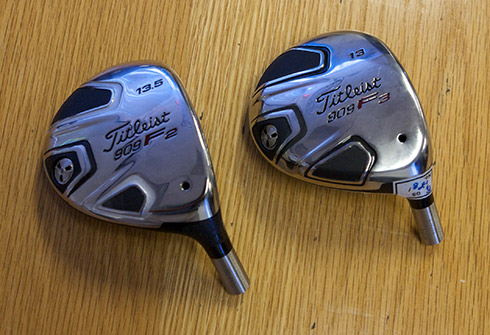
The 909 F2 and F soles. The thing to note here, in addition to the different accent colors, is the difference in head size and shape.
The soles of the 909 fairway metals has been glitzed to the nines (or is it the eighteens?), with a spiffy undercarriage of shiny silver. Even the SureFit Swingweight Screw looks a bit more “high tech” than the previous generation tungsten weight. Each model features a paint highlight on the sole – silver in 909F2 and black in 909F3, just like their driver brethren – that differentiates the models at a glance.
As I said in the 909H review, I don’t really care for the look of the soles. It’s a bit “too much” for me. But I also realize two things: 1) A unique sole is easier to see on television during PGA Tour play, a key means of marketing, and 2) You don’t see any of the shininess when you’re actually looking down at the club preparing to hit the golf ball. So consider this a minor quibble at most.
The crown continues the trend of adding a little glitz and glamour, but in a way that I like. Like the 909 hybrids and drivers, the 909F drops the solid black gloss finish on 906 and adds a bit of sparkle. It’s a bit like the finish Titleist used to use on its metalwoods, but much darker. It’s attractive and does a better job of framing the ball by breaking up distracting highlights and reflections. Titleist’s traditional raised triangle/bar logo marks the center of the clubface, and I’ve got no quibbles with that at all.
The remaining elements act to counter-balance the glitzy sole to maintain the appearance one has come to expect from Titleist. The hosel and toe are sparsely decorated. The lines are clean though sharp in contrast. In total, with the clean appearance at address and the spiffy, glitzy undercarriage, the 909F is saying “I look like you’d expect, but I’ve got some technology under the hood as well.”
Performance
I’ve carried a Titleist fairway metal for quite a few years: the 980F was replaced by the 904F, which was replaced by the 906F. And yes, the 909F3 has replaced the 906F2, though not quite as easily as earlier models.
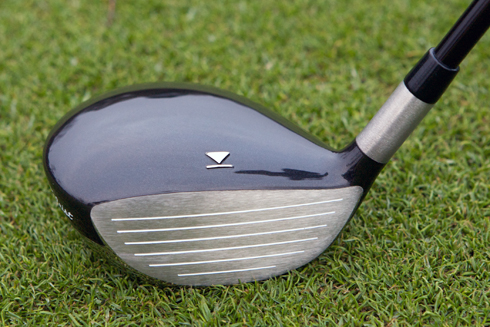
I tested a 909F3 with both an Aldila Voodoo and a UST ProForce v2. Both models served as my three-wood and measured 15°. I consider myself a good fairway wood player. I hit 3W from the tee regularly as well as from the fairway, rough, and even a waste bunker or two. I ask for a club that can keep the ball down when I need it, and I’m almost always working the ball left or right, often as a means of distance control.
All told, the 906F2 and 909F3 perform rather similarly. The differences between them present a series of tradeoffs I’m not entirely certain I like.
First, the 909’s deeper CG removes a bit of the workability I came to enjoy from the 906. Fades and draws with 909F3 require a bit more effort to get the ball moving. Rather than slide left or right, the ball had a tendency to want to just stay on the line on which it started.
Vertical workability also took a bit of a hit with the 909: the ball wants to stay a bit higher at all times. Hitting a low punch is a bit more difficult. Unlike the left-right workability, I didn’t find this to be a problem at all because the ball also seemed to come off with a bit less spin than with 906. Even with the higher launch the ball carried adequately, thus removing some of the need to even attempt a punch shot.
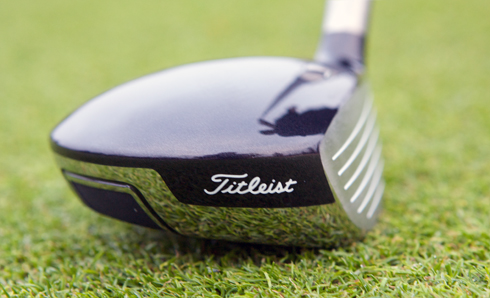
The upside of the deeper CG is that the 909F is a bit more forgiving than 906F. Mis-hits travel straighter and farther off 909 than they would have off 906. For those who don’t like to work the ball, or those who battle over-working the ball, the “tougher to curve” feature is a welcome, positive feature.
Like 906, the club performed similarly from a variety of lies, including from the tee, the fairway, and those pestering waste bunkers. Though the more rounded looking sole did not appear to me to be as capable of “getting down to the ball” in cuppy lies, it proved to be another case of “appearances can be deceiving.” The 909 is nearly every bit as good at digging the ball out as 906. This is likely due to the continued use of the “Multi-Relief Sole” as well as the added clubface area low and towards the toe and heel, both of which we first saw with 906F.
As I discovered with the 909H fitted with the stock Aldila Voodoo shaft, the 909F3 with the Aldila Voodoo flew a bit higher than I like. I found myself giving up about ten yards of distance with the higher ball flight and could never visually adjust to the higher trajectory. Reverting to the same UST ProForce v2 I had in my 906F2 pretty much solved the height and distance problem, and serves as yet another example of why getting fit for your equipment is the only way to go.
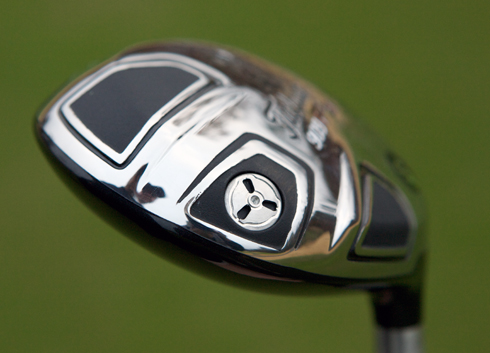
Also much like I found with 909H, I don’t particularly enjoy the sound the 909F3 makes at impact. It’s a higher pitched, more metallic sound than I like from my fairway woods. I prefer a slightly more solid, lower-pitched “crack.” I won’t belabor this point – I know how much effort Titleist puts into testing and tuning the audio feedback of their clubs, and so my hunch is that a lot more golfers will like the sound of 909F than won’t. The higher pitched sound probably comes off as “hotter” than 906’s more muted sound to most.
Though I know I talked about it already, I give high marks for the speckled paint finish. It really does a good job of not only masking reflections, but also diminishes the distracting impact of things like water droplets.
I’ve admittedly glossed over a lot of the normal features. If you’re really into fairway metal reviews, go on back and ready my 906F4/F2 review, which contains plenty that continues to hold true of the 909F, like this:
At impact, the sole’s contact point is closer toward the clubface, allowing for increased versatility in not only playability from differing lies but in angle of attack and shot selection. With the 904F, hitting a high shot played well forward in your stance was difficult given the contact point further back on the sole. Attempting such a shot often resulted in slightly thin shots that came out lower than normal. With the 906s, this shot is relatively simple, as are the others like a stock shot, a “pinch” shot back in your stance, and even shots from fairway bunkers. Likewise, shots from the thinnest of fairway lies or even hardpan are made easier with the improved sole and contact point.
I could repeat myself, but there’s little point in that. Titleist has had some pretty good fairway woods for awhile now, so little has changed about how the club performs, and there’s nothing wrong with that. If it ain’t broke…
Extras and Specs
909F2 and F3 are available for both righties and lefties in lofts of 13°, 15°, and 18° (+0.5° for 909F2). Both offer stock shafts in the Diamana Blue 75 and the Aldila Voodoo with a wide range of custom shafts. The stock grip is, of course, the Titleist Tour Velvet with the logo turned down. Shaft length is 43″ on the two lower lofted clubs and 42.5″ on the 18/18.5° models. Every clubface is 0.5° open and lie angles are 57°, 57°, and 57.5°.
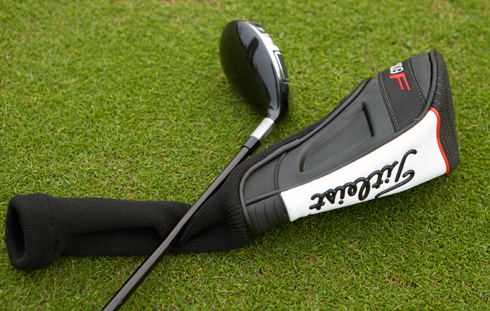
Though I prefer the 906 headcover, there’s no arguing that 909F’s stock headcover matches the 909H and 909D headcovers: it’s a sock type with a heavier, thicker plastic upper region emblazoned with bold black, red, and white graphics. It, you know, covers the head…
Conclusion
Though it may shock those who seem to think that Titleist has bought and paid for glowing reviews on this site (really, people, do some research first), I’m not over the moon about the 909F3. If I were in a bad mood when you asked me about it, I’d say that someone took my 906, shined up the sole, changed the impact sound, and removed a little of the workability.
On the flip side, the loss of workability will be seen by most as “more forgiving.” The part you actually see when playing golf – the crown – improves the look of the club at address. And the sound, well, I realize as you probably do that performance is what matters: I might play a club that meowed at impact if it worked.
Have I switched to 909F3 from 906F2? Yes. The decrease in spin put it over the top. 906F2 didn’t balloon in flight, but it was more affected by the wind than 909F3. Sure, I’ll have to work a little harder to hit cuts and draws, but I’m pretty sure I can adjust to hitting the ball a little straighter. 😉 After all, I’m in the minority when talking about added forgiveness as a bad thing.
Besides, given how much I like the improvements 909H made over 585.H and 909D3 made over 907D2, I’ve gotta have matching headcovers, don’t I?
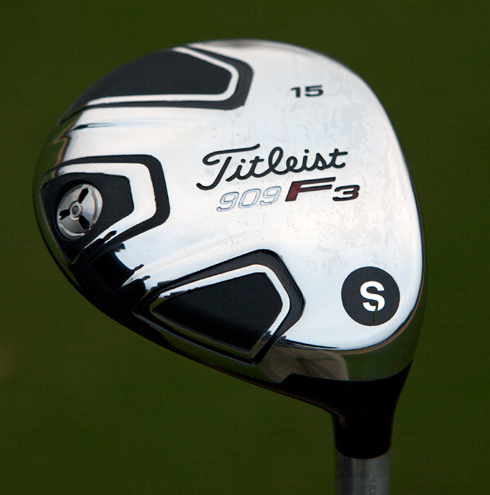
Simply put, it’s tough to get excited about a fairway wood. They aren’t sexy like drivers or as personal as putters. They don’t spin the ball back 20 feet like a wedge and most people won’t stick their 3W to a few inches like they can with their irons. 909F tweaks the performance characteristics of 906F in a way that most will find quite acceptable, and there’s nothing wrong with that. It’s just not exciting.
One final word, and one that I know Titleist agrees with: fitting. Get fit. The difference in performance between two identical clubheads with two shafts that had very similar but not identical characteristics was quite noticeable. The right shaft makes a big difference in any club, so when testing 909 fairway metals on the range, do yourself a favor and try a variety of shafts and weights.
P.S. For more information, please also check out our Sneak Peek and our podcast discussing 909 fairway metals.

Nice review, I’ve been mulling over finding a 3 wood for about 2 years now. Hopefully I can find the right one.
Great review. Even has a mid/high-handicap, I picked up a used 904f a couple years back after you reviewed it. Can you compare these 909s a bit more directly to the 904f in terms of head size/shape and forgiveness.
While it seems the F2 is said to be more “forgiving” than the F3, I will use this 90% of the time from the tee so I wonder if a deeper faced F3 would be wiser. Thoughts?
Thx.
Great review – I have been guilty in the past of suggesting a Titleist bias on this site however found what you said here interesting, balanced and very fair.
I bought a 906 f4 last year – it is excellent – and on the basis of this review I think I’ll stick with it. (I might just nip to the range for a test run of the 909F2 though…)
Cheers!
Love reading your reviews keep it up.
I have played the 906F4 since it came out and love it, I think I will keep it in the bag, even though the 909 seams to be a great club and a slight improvement over the 906 line of fairway woods.
thanks
Most of the people that suggest such things either a) haven’t read every Titleist review we’ve done here, or b) haven’t noticed that other companies get positive reviews of their equipment as well. We’ll come down on a product when it’s bad, but the fact of the matter is virtually every piece of equipment out there is good for something. If it were total crap, the companies probably wouldn’t release it.
Yes, an improvement, particularly in the forgiveness (and the looks).
Does anyone know how many grams the voodoo 3 wood shaft is?
I think you’ll come to learn that Titleist usually does a pretty good job of making this information available if you take the time to look: Flex – R, S, X; Weight (g) – 80, 81, 83.
I love my woods (Pro select). When I become in the market to update my woods it will be hard to compair. the proselect came from a full set but the 5 wood is my go to club ad the 3 wood is easy to hit. old. but from the look of these I wouldn’t mind at least giving them a go. Good review. will try them eventualy for sure.
Thanks for the good review Erik,
I have had the 15 f3 for a month or so and I absouloutly love it!
Thanks Erik!
The first time i looked i couldn’t find it on the site.
Great review, hope the 909D drivers review is on the way.
GREAT FAIRWAY WOODS THE BEST EVER! 😀
The f 3 -15 degrees is amazing with lots of forgiveness! However, I strongly recommend that you get properly fit for a good shaft to max-out the club for accuracy and length. The Standard OEM shafts are not very good. Upgrade the shaft it makes all the difference. If you are ever in San Diego use a club fitter named Brad he really know his stuff. Buy the F3 its an awesome club with plenty of forgivness. Hit them straight Cheers!
Great Review…
Needed some more help if anyone can give me some advice. I have the 907 D2 9.5 and Callaway X FW (3 and 5 wood). I never came around to changing my FW’s until now. I tried the 909F2 and the 909F3 and felt that 909F3 was easier to hit off the tee (which I do more of). However, I am scared that buying the F3 would be disadvantages if I don’t get to play much…Any ideas? I shoot in the high 70’s to low 80’s. I have been playing some of my best golf this past season, so I am worried that by getting the F3 I will regret it later when I don’t get to play as much…
I am also planning to get ride of my 5W and replacing it with the 909H – but wasn’t sure if I should get the 17 or 19 degree. Based on reviews the 17 degree would be more like a 5W/2I, correct?
Thanks!
I replaced my 2 iron with a 585H last year. My hybrid is 40.5″, 19* with a UST V2 100 shaft and it goes maybe 10 yards farther than my 2 iron did. I believe the new 17* 909H comes with a standard length of 41″.
As a side note the 585H quickly became my favorite club and i just bought another ($76 after shipping thanks EBAY) to replace my 3 iron.
I’ve never hit a Titleist club until this year, being afraid of the “player’s club” label, and wanting to make the game as easy as possible. I believe I wasn’t giving myself enough credit and just scared of the reputation. I have a driver ss of around 115 and coming into this year I was a 12, and currently at an 8. I believe a lot of this has to do with my club switches. First, I swapped out my Cleveland Hibore 15* with the red shaft in x-stiff, and went to the F3 15* with a Voodoo x-stiff and it’s amazing. My occassional miss with this is a little thin, but you don’t lose very much distance, even at the low trajectory because this club keeps the spin down and in the fairway and it rolls and rolls. I spoke to my local clubfitter about possibly going to the F2 15.5* to elimate the thin shots, but he said the increase in spin would probably put me at the same distance as my F3 18*, which I switched to from a Callaway 18* X-hybrid with an NV-85 x-stiff. Since these worked so well, I also swapped out my Cleveland Hibore XLS 9.5* with the red shaft in x-stiff for a D3 9.5* with the Voodoo x-stiff. I’ve learned that most forgiving isn’t always the best way to go, in my case anyways. These clubs provide much, much more feedback and are much more rewarding when your swing is clicking. They helped me to recognize what I was doing wrong so I could work on fixing those flaws, rather than mask them. All in all, I put these above anything else out there, but based on my swing and game. Like the man said, nothing is more important than getting fit. My local guy spent an hour or better with me on the l.m. with a half dozen different shafts. It’s nice to go out and know you have the right equipment rather than emptying your pockets to try different things.
If you are swing at 110 mph why don’t you use the 13 degree F3?
Why would I? It doesn’t gap out correctly. I play a driver, a 15 degree 3W, and a hybrid, then into the irons at a 3-iron.